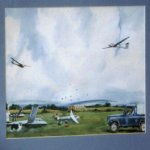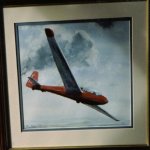
You arrive at your local Gliding Club and talk to the first person you see. The response from that person may be varied. Ideally they should welcome you warmly and introduce you to the Duty Instructor of the day who will assist and guide you to ensure that your first encounter with a Gliding Club is a pleasurable experience. Your subsequent flying training will be based on a first come, first served basis. The usual routine is to put your name on the flying list as soon as you arrive, wait your turn (helping out as much as possible), have two or three flights with an instructor then continue to help out until the end of the flying day. This is the traditional route into gliding but can be demoralising, as the rate of progress might be painfully slow.

You arrive at your local Gliding Club where you are warmly received, introduced to the Duty Instructor, offered a trial lesson (which may include temporary membership for as long as three months) and encouraged to book onto an intensive training course. These are normally carried out on a Monday to Friday basis and prices and details vary from club to club. Instruction on courses is usually given with two or three students per instructor.
During your first few flights with an instructor you will be shown how to use the controls to make the glider go the way you want it to and you will operate the controls yourself, getting as much practice as you need. You’ll also learn why it responds in the way it does and what happens if you use the controls incorrectly (nothing dramatic! the glider flies itself, we just tell it which way to go).
As you progress through the BGA syllabus, your skills and knowledge will build up, but always at your own pace. Eventually you will feel that you can do this without the presence of an instructor in the cockpit, in fact, you can’t wait!
The first big achievement for anyone learning to fly is to go solo, but this will happen only when both you and your instructor are happy that you have the confidence and experience to do so in complete safety.
Gliding is a sport that continues to challenge us and there is always more to learn. All solo pilots take check flights with an instructor from time to time but, at any stage, it may be beneficial to receive further training.
It is possible that a few bad habits may have developed in your flying, that you are frustrated at not being able to soar as well as some of your fellow pilots or that a few fears or worries are starting to creep in thus inhibiting your progress. Perhaps you want to work towards becoming an instructor yourself.
Whatever your level of experience, it is always useful (and surprisingly good fun) to fly with someone who can help you to gain a deeper understanding of the sport, to progress further and get more out of your flying by passing on more of their knowledge.
The cross country endorsement is done with an instructor, often during one day’s intensive tuition and testing. It involves a thorough briefing on navigation and field landings followed by a practical exercise of a few hours in a motor glider. This enables you to navigate around a cross country flight with several simulated field landings without having to wait for just the right weather.
If you have decided to take a gliding course, I seriously suggest you come to Shenington Gliding Club. There you will be made very welcome and will very quickly become ‘one of the family’. Shenington runs first class courses at very competitive rates. Full details can be obtained by going to the Shenington website www.shenington-gliding.co.uk.
Operating alongside the club courses,or indeed teaching on them, I teach on a one-to-one basis in my own glider. As you have my time completely at your disposal, we can devote as much as you like to theory briefings and we can pace ourselves over the day to suit you. It’s not uncommon to have 10 winch launches in a day in addition to a thorough briefing and debrief.
Many pilots come to me because, over a time, they have developed particular fears or concerns about their flying and it is not unnatural to be reluctant to express these anxieties at one’s home club. I can help by devoting the time necessary to discuss any aspects of flying and still have plenty of scope for the flying required. I understand that, for many, time is a rare and valued commodity and I ensure that every minute of the day is used productively.